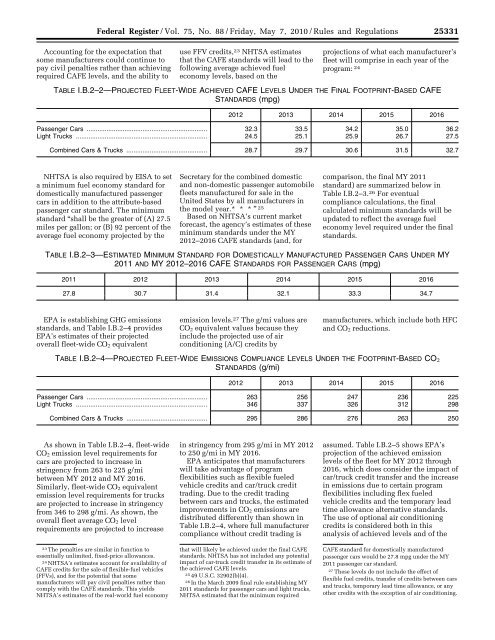Tailpipe Rule - GlobalWarming.org
Tailpipe Rule - GlobalWarming.org
Tailpipe Rule - GlobalWarming.org
Create successful ePaper yourself
Turn your PDF publications into a flip-book with our unique Google optimized e-Paper software.
Federal Register / Vol. 75, No. 88 / Friday, May 7, 2010 / <strong>Rule</strong>s and Regulations<br />
25331<br />
Accounting for the expectation that<br />
some manufacturers could continue to<br />
pay civil penalties rather than achieving<br />
required CAFE levels, and the ability to<br />
use FFV credits, 23 NHTSA estimates<br />
that the CAFE standards will lead to the<br />
following average achieved fuel<br />
economy levels, based on the<br />
projections of what each manufacturer’s<br />
fleet will comprise in each year of the<br />
program: 24<br />
TABLE I.B.2–2—PROJECTED FLEET-WIDE ACHIEVED CAFE LEVELS UNDER THE FINAL FOOTPRINT-BASED CAFE<br />
STANDARDS (mpg)<br />
2012 2013 2014 2015 2016<br />
Passenger Cars ................................................................... 32.3 33.5 34.2 35.0 36.2<br />
Light Trucks ......................................................................... 24.5 25.1 25.9 26.7 27.5<br />
Combined Cars & Trucks ............................................. 28.7 29.7 30.6 31.5 32.7<br />
NHTSA is also required by EISA to set<br />
a minimum fuel economy standard for<br />
domestically manufactured passenger<br />
cars in addition to the attribute-based<br />
passenger car standard. The minimum<br />
standard ‘‘shall be the greater of (A) 27.5<br />
miles per gallon; or (B) 92 percent of the<br />
average fuel economy projected by the<br />
Secretary for the combined domestic<br />
and non-domestic passenger automobile<br />
fleets manufactured for sale in the<br />
United States by all manufacturers in<br />
the model year.* * * ’’ 25<br />
Based on NHTSA’s current market<br />
forecast, the agency’s estimates of these<br />
minimum standards under the MY<br />
2012–2016 CAFE standards (and, for<br />
comparison, the final MY 2011<br />
standard) are summarized below in<br />
Table I.B.2–3. 26 For eventual<br />
compliance calculations, the final<br />
calculated minimum standards will be<br />
updated to reflect the average fuel<br />
economy level required under the final<br />
standards.<br />
TABLE I.B.2–3—ESTIMATED MINIMUM STANDARD FOR DOMESTICALLY MANUFACTURED PASSENGER CARS UNDER MY<br />
2011 AND MY 2012–2016 CAFE STANDARDS FOR PASSENGER CARS (mpg)<br />
2011 2012 2013 2014 2015 2016<br />
27.8 30.7 31.4 32.1 33.3 34.7<br />
EPA is establishing GHG emissions<br />
standards, and Table I.B.2–4 provides<br />
EPA’s estimates of their projected<br />
overall fleet-wide CO 2 equivalent<br />
emission levels. 27 The g/mi values are<br />
CO 2 equivalent values because they<br />
include the projected use of air<br />
conditioning (A/C) credits by<br />
manufacturers, which include both HFC<br />
and CO 2 reductions.<br />
TABLE I.B.2–4—PROJECTED FLEET-WIDE EMISSIONS COMPLIANCE LEVELS UNDER THE FOOTPRINT-BASED CO 2<br />
STANDARDS (g/mi)<br />
2012 2013 2014 2015 2016<br />
Passenger Cars ................................................................... 263 256 247 236 225<br />
Light Trucks ......................................................................... 346 337 326 312 298<br />
Combined Cars & Trucks ............................................. 295 286 276 263 250<br />
mstockstill on DSKB9S0YB1PROD with RULES2<br />
As shown in Table I.B.2–4, fleet-wide<br />
CO 2 emission level requirements for<br />
cars are projected to increase in<br />
stringency from 263 to 225 g/mi<br />
between MY 2012 and MY 2016.<br />
Similarly, fleet-wide CO 2 equivalent<br />
emission level requirements for trucks<br />
are projected to increase in stringency<br />
from 346 to 298 g/mi. As shown, the<br />
overall fleet average CO 2 level<br />
requirements are projected to increase<br />
23 The penalties are similar in function to<br />
essentially unlimited, fixed-price allowances.<br />
24 NHTSA’s estimates account for availability of<br />
CAFE credits for the sale of flexible-fuel vehicles<br />
(FFVs), and for the potential that some<br />
manufacturers will pay civil penalties rather than<br />
comply with the CAFE standards. This yields<br />
NHTSA’s estimates of the real-world fuel economy<br />
in stringency from 295 g/mi in MY 2012<br />
to 250 g/mi in MY 2016.<br />
EPA anticipates that manufacturers<br />
will take advantage of program<br />
flexibilities such as flexible fueled<br />
vehicle credits and car/truck credit<br />
trading. Due to the credit trading<br />
between cars and trucks, the estimated<br />
improvements in CO 2 emissions are<br />
distributed differently than shown in<br />
Table I.B.2–4, where full manufacturer<br />
compliance without credit trading is<br />
that will likely be achieved under the final CAFE<br />
standards. NHTSA has not included any potential<br />
impact of car-truck credit transfer in its estimate of<br />
the achieved CAFE levels.<br />
25 49 U.S.C. 32902(b)(4).<br />
26 In the March 2009 final rule establishing MY<br />
2011 standards for passenger cars and light trucks,<br />
NHTSA estimated that the minimum required<br />
VerDate Mar2010 20:30 May 06, 2010 Jkt 220001 PO 00000 Frm 00009 Fmt 4701 Sfmt 4700 E:\FR\FM\07MYR2.SGM 07MYR2<br />
assumed. Table I.B.2–5 shows EPA’s<br />
projection of the achieved emission<br />
levels of the fleet for MY 2012 through<br />
2016, which does consider the impact of<br />
car/truck credit transfer and the increase<br />
in emissions due to certain program<br />
flexibilities including flex fueled<br />
vehicle credits and the temporary lead<br />
time allowance alternative standards.<br />
The use of optional air conditioning<br />
credits is considered both in this<br />
analysis of achieved levels and of the<br />
CAFE standard for domestically manufactured<br />
passenger cars would be 27.8 mpg under the MY<br />
2011 passenger car standard.<br />
27 These levels do not include the effect of<br />
flexible fuel credits, transfer of credits between cars<br />
and trucks, temporary lead time allowance, or any<br />
other credits with the exception of air conditioning.


